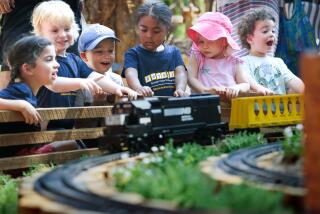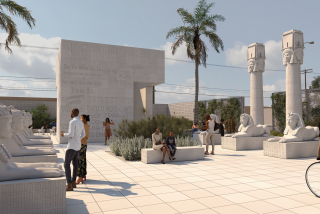Sculpture Blooms on Mall in Washington
WASHINGTON — In a new circular garden in an old rectangular promenade, an anthropomorphic bronze rabbit sits perched upon a corrugated bronze rock. It’s thinking.
A playful throwback to Rodin’s famous work, Barry Flanagan’s “Thinker on a Rock” greets visitors to the recently opened National Gallery of Art Sculpture Garden. The 6-acre sanctuary of artworks and artistically arranged flora opened late last month on the National Mall, best known as home to the Washington Monument and the Lincoln Memorial.
Boasting sculptures by such renowned artists as Roy Lichtenstein, Louise Bourgeois and Mark di Suvero, the garden was unveiled in time to accommodate the crush of summer visitors who descend upon Washington, including thousands from Southern California. It also is part of a larger plan to revitalize the National Mall for the July 4 weekend in 2000, when the first Independence Day celebration of the new century is expected to draw even more tourists to town than usual.
Earl A. Powell, the National Gallery’s director, says its aim is to offer “a different experience from walking along the great sweep of the Mall. A bit more personalized, perhaps.”
The outdoor art gallery sits directly across from the Hirshhorn Museum and Sculpture Garden, which for 25 years has housed artworks inside its walls and outside in its own garden. The new sculpture garden lacks the Hirshhorn’s high walls and cloistered enclaves, making it more park-like in appearance.
And while the Hirshhorn has always provided visitors more of a historical artistic experience, the new garden features works exclusively from the post-World War II period.
“The idea was to have the two gardens complement each other,” Powell said. “I personally think they do it handsomely.”
The new garden’s sculptures, 17 in all, will reside there on a more or less permanent basis, although Powell said their location on the premises was “flexible.”
The works were not specifically commissioned for the garden, but Powell said he and his associates worked closely with several of the artists to decide which of their pieces would work best in the setting.
Already, some critics have reached a consensus on the garden’s most powerful work: “Aurora,” Di Suvero’s combination of design and creative engineering. Its structural system distributes 8 tons of steel balanced over three diagonal supports.
Visitors interested in taking in the entire garden at a glance can use Scott Burton’s “Six-Part Seating,” a circular group of polished, red-granite seats. Each seat offers a panoramic view of the garden.
Lichtenstein’s contribution, “House 1,” incorporates what Powell called hallmark elements of the artist’s two-dimensional works: crisp elemental drawing delineated by heavy black outlines and a palette based on primary colors. Exploiting an illusionist effect, “House 1” appears to project forward from a distance, although it actually recedes into space.
The 14-month, $13-million project was supervised by landscape architect Laurie Olin. He centered the new garden around an expansive central reflecting pool, a fountain by summer and skating rink come winter.
Most critical reaction has been favorable.
“Even people who come to [the garden] casually, tourists or those vaguely interested in art . . . will find something there to spark some new ideas,” said Alison Hilton, associate professor of art history at Georgetown University. “They won’t have to go into a museum and commit to viewing a slew of works.”
“The juxtapositions between the sculptures and the environment around them . . . were all framed in a well-thought-out way,” said Lenore Miller, director of the Dimock Gallery at George Washington University.
But not all reviews have been positive.
Mark Oxman, a fine arts professor and director of the sculpture program at American University, dismissed the garden’s collection as “predictable.”
“It’s like going to a party and everyone’s wearing three-piece suits,” he said. “There isn’t anything there that is really challenging, or something that would knock the socks off you, your children and your grandchildren. . . . I wonder if the next generation will look upon these pieces of art like they would look upon their grandfather’s car.”
Although Powell said he favored keeping the garden distinctively post-World War II in flavor, he allowed that the committee overseeing it will probably approve changes over time.
“This museum is going to be a nice alternative for people tired of solely indoor experiences,” Powell said.
More to Read
The biggest entertainment stories
Get our big stories about Hollywood, film, television, music, arts, culture and more right in your inbox as soon as they publish.
You may occasionally receive promotional content from the Los Angeles Times.










